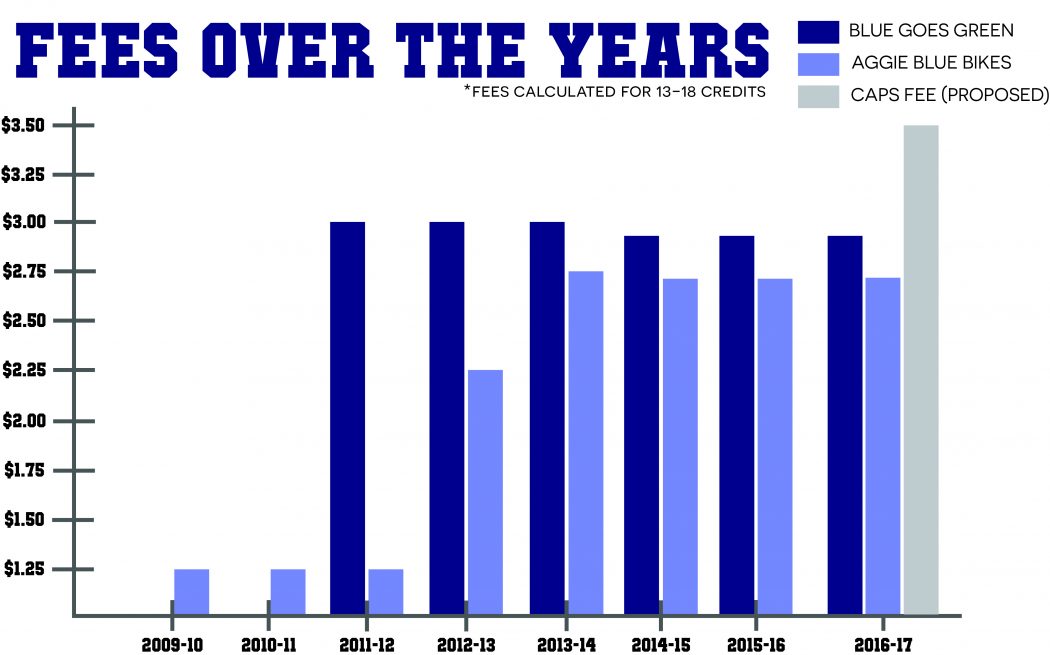A brief (contemporary) history of student fee proposals
The Utah State University Fee Board (USFB) will hold a vote on Feb. 8 to decide — among four other fee proposals — whether to allow a new fee for Counseling and Psychological Services (CAPS) to be brought before the general student body as a measure in the spring elections.
The USU student body hasn’t seen a new fee since the 2011-2012 school year, when a sparkling $3 fee for the university’s Blue Goes Green program first graced the tuition and fee schedule.
Prior to that, USU students saw a new $1.25 Aggie Blue Bikes fee during the 2009-2010 school year. Before that, well, if you wanted to find anything, you’d have to search deep into the beginnings of the internet, sifting through odd PDF files and legislative documents stored in a database that may as well be David Bowie’s labyrinth (RIP, the Starman).
Which is to say, it’s been a while.
So fee creations don’t happen often. This is because the fee structure is already tailored fairly well to fit students’ outside-of-the-classroom wants and needs. When a new fee does reach the USFB, generally, it is because a need among the student body manifests and, to suit that need, a fee is created.
Both the Aggie Blue Bikes fee and the Blue Goes Green fee fall into a similar category in terms of need. Each fee was championed by those who wanted to see a more sustainable and environmentally friendly campus.
With that said, creating a fee is still a difficult process — after all, a “need” can quickly become something superfluous when paying for it becomes a reality.
Take the Blue Goes Green fee, specifically. In USU’s 2011 elections — back when the acronym for the Utah State University Student Association was still ASUSU — the fee, according to the Statesman’s editor-in-chief at the time, Catherine Meidell, met considerable opposition by the USFB but was eventually approved by a vote of 2,305 to 1,952.
The student vote was split nearly fifty-fifty, meaning just over half the students at the time were all right with an extra $3 a year and a little under half were not. Creating a fee, by that token, is no small task — perhaps only a matter of a couple hundred votes.
The CAPS fee, if the most recent USFB meeting is any indication, will possibly fare better than the Blue Goes Green fee did in 2011. Nearly every member of the USFB who participated in the discussion of the CAPS fee spoke in favor of it, citing USUSA’s recent initiative to declare a mental health a crisis on USU’s campus and to encourage other campuses across the state to do the same. As USUSA president Ashley Waddoups noted, it would be “very hypocritical if we don’t put our money where our mouth is.”
Additionally, considering CAPS director David Bush’s presentation at the same meeting, wherein he indicated that a little over 1,200 students sought support from CAPS in the past year, the $3.50 CAPS fee may strike the general student body as something more urgent than, say, grant money for recycling programs did in the past.
That sense of urgency — again, spurred heavily by USUSA’s recent legislative initiative — is what, to many, makes the fee necessary.
“It doesn’t matter where you go, mental health is an issue,” Matthew Clewett, USUSA’s student advocate vice president, said in the most recent USFB meeting. “We’re not just going to pass a resolution. It’s an appropriate step to show the student body is in full support.”
Waddoups, too, stressed the urgency of the fee — especially for its lobbying power moving forward.
“We can’t continue to ask for money, if we as students aren’t doing our part,” she said.
— jordan.floyd@aggiemail.usu.edu
Graphic by Emmalee Olsen

